A Philadelphia Bike Lane Learning Experience
In My First Post
…about bike lanes in Philadelphia, I showed how I rode on Spruce Street, a narrow one-way street in Center City with a bike lane.
When my safety required it, I merged out of the bike lane — for example, whenever I might be at risk from a right-turning motor vehicle. At those times, it was safest to be in line with motor vehicles, where the driver behind me could see me.
Such Assertiveness May Seem Strange and Forbidding
It’s indeed counterintuitive to practice “driver behavior,” and take your place in the queue with motor vehicles. Yes, they are big, and heavy, and they can go fast. But these vehicles also are controlled by drivers. You use head turns and hand signals to communicate with drivers, and move into line when one has made room for you. That driver’s vehicle is protecting you from all the other ones behind!
Putting “driver behavior” into practice on Spruce Street was easy, as traffic there is mostly slow. I had no trouble just falling into line with vehicles waiting at a traffic light.
A First-Timer’s Mistakes
If you think that CyclingSavvy Instructors always do everything right, watch today’s video. This was my first ride ever on Spruce Street. I wouldn’t do everything quite the same way a second time.
There were a couple of times when I didn’t move far enough OUT of the bike lane. I was in line with motor traffic, but I stayed in the right tire track — on the passenger side of cars — so that bicyclists in the bike lane would show in my video.
Right Tire Track Distracted Me From My Safety
That distracted me from an option which would have made my ride go better. As I reviewed raw footage, it dawned on me that most of the streets which cross Spruce Street are one-way. Some are one way right-to-left, others left-to-right.
I could take advantage of this!
Avoiding Unnecessary Delay at Intersections
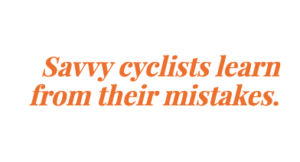
Things would have gone more smoothly if I had been riding farther to the left. That is my usual practice where traffic can turn right, but it is even more emphatically correct where traffic can’t turn left.
I still won’t pull all the way over to the left, out of line with the motor traffic: even if a motorist is unlikely to turn the wrong way into a one-way street, one could still merge over to the left curb, like the one who merged over to the right curb in my video. It’s safest to wait in line.
Just For Fun
I’ve included a third incident where the mistake was made years earlier, in the design department of an automobile manufacturer halfway around the world.
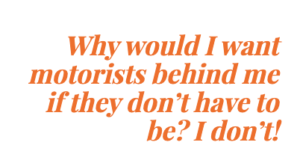 In this segment, the driver did use a turn signal, but it was so far around on the other side of the car, I couldn’t see it.
In this segment, the driver did use a turn signal, but it was so far around on the other side of the car, I couldn’t see it.
This driver was yielding right-of-way to me when I should have yielded to him. To avoid a “no, you go first” situation, I went ahead. If I’d known that the driver wanted to turn right and would have to follow me, I would have been more assertively polite. Why would I want motorists behind me if they don’t have to be? I don’t!
The first two incidents illustrate why I never assume motorists will use their turn signals. The third incident brought home to me that I sometimes can’t assume that they are not using turn signals.
Savvy Cyclists Learn From Their Mistakes
While I kept safe, the encounters I’ve described could have gone more smoothly. Every ride can be a learning experience, and the next ride can go better.
More to Come
I have one more post about Spruce Street on the way. So far I’ve done my best to avoid discussing politics and religion.
But in my final Spruce Street post, churches are involved. In that post I’m going to let loose!

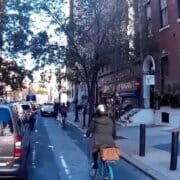
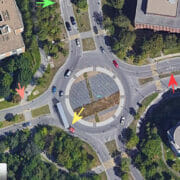
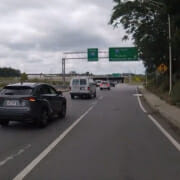
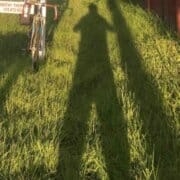
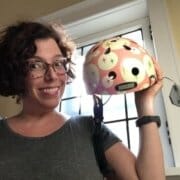
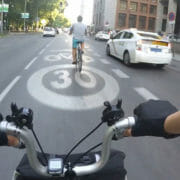
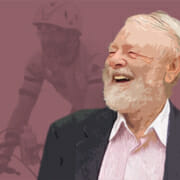
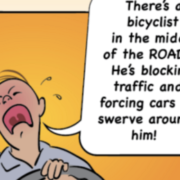
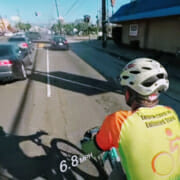



What a pleasure to see and to read the “Return of the Savvy Cyclist!” My compliments to both Karen and John for a job very, very well done!
One hopes, however, that John’s forthcoming post promising to include Spruce Street churches will be truly interfaith as well as genuinely ecumenical. At 418 Spruce Street is the Society Hill Synagogue, located in the former Spruce Street Baptist Church. The church/synagogue is a Philadelphia landmark, designed in 1829 by the architect of both Girard College in The City of Brotherly Love and the Dome of the U.S. Capitol.
Harold, sorry, I rode Spruce Street from the 1000 block up on a Sunday morning, and had to pass vehicles parked in the bike lane by goyim who were attending a couple of big old churches. In the interest of ecumenism, when I’m in Philly again for the Bike Expo this year, I’ll check out the action in the 400 block on Friday evening or Saturday, and report back to you :-)
Very helpful. How can we get city staffers to not place bike lanes in door zones? Is the answer to have them placed to the right of parked cars or would it be better to have sharrows in place of bike lanes in these instances?
Door zone bike lanes continue to be installed, unfortunately, because they meet design standards. It’s been a very frustrating uphill battle for us to get that changed.
Placing bike lanes to the right of parked cars potentially introduces a new set of problems. People bicycling in this area are not visible nor relevant to turning and crossing traffic at driveways and intersections. Also often times these bikeways aren’t wide enough to allow easy passing of slower riders, obstacles, or debris, and sometimes they’re even in the passenger side door zone. Those who are driving those parked cars and their passengers also often have to step across the bikeway to access their destination or pay a parking meter. In other words moving the bike lane behind parked cars exchanges one set of problems for another.
Of course there’s the option to remove the parking but that’s often very unpopular with local residents and businesses.
Properly placed sharrows and Bikes May Use Full Lane (BMUFL) signs can help but ultimately many people still will ride close to or within the door zone unless they’ve been made aware of the hazards of riding in the door zone.
Savvy Cyclist has written about door zone bike lanes in the past as well:
https://cyclingsavvy.org/2018/05/the-real-door-zone-tragedy/
https://cyclingsavvy.org/2018/08/bike-lanes-dooring/
Thanks Frank:
I appreciate your prompt and thorough reply. I agree my suggestion would just switch one set off problems for another.
This is real world in my area as we lost a dedicated cyclist this year when he swerved from a bike lane to avoid being doored and was hit from behind. Unfortunately the public discourse rushed to judgement and no valid strategy has emerged to prevent the same thing happening again.
There are valid strategies to avoid the dooring problem. Some can come from government, with better infrastructure choices, but mostly from individual cyclists by route choice and by staying out of the door zone on streets with parking. Fortunately, Spruce street is one-way with parking on only one side, except for the few blocks where parking is allowed for church services. The only workable option there is to ride centered in the lane. But this is a little street with slow traffic, and I didn’t have a problem doing that.